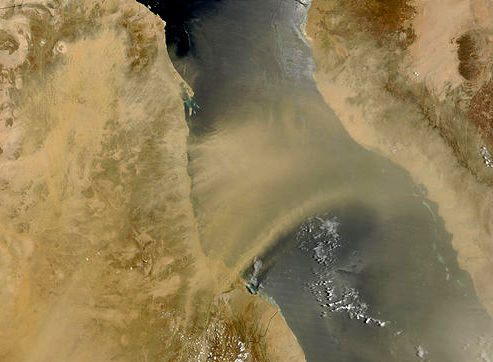 Windblown dust flowing over the Red Sea as seen from space; Image courtesy of NASA
Windblown dust flowing over the Red Sea as seen from space; Image courtesy of NASABohumil Shimek wasn't the only one, or the first, to apply good science techniques to the question of where our loess came from. Long before Shimek's 1902 paper using Natchez snails to prove that loess was wind-deposited, US geologist and explorer Raphael Pumpelly in a landmark 1879 paper had made the argument that loess was wind-deposited.
 Raphael Pumpelly (1837-1923); public domain image courtesy of Wikimedia Commons
Raphael Pumpelly (1837-1923); public domain image courtesy of Wikimedia CommonsPumpelly had studied loess in China and America and come to all the right conclusions. Similarly well before Shimek, Boston snail specialist Amos Binney had recognized that the snail species found embedded in loess were forest-litter species, not streambed ones. However, Binney had continued thinking, along with Sir Charles Lyell, that loess was water-deposited. However, the fine work of these two scientists made little impact on geology's big guns and were mostly ignored. Unfortunately, in science, as in nearly everything else, having good timing and the right people support you often is more important than deploying mere genius.
The debate was still going on in 1942 when G.D. Smith published a paper on Illinois loess. In about forty localities Smith measured how deep the loess was and found this: That loess was thickest near the river, and got thinner away from it. Moreover, like so many grand phenomena presided over by elemental laws of Nature, the rate of thinning out was beautifully, even exquisitely, predictable, and could be expressed with sublime succinctness. Smith said that the rate of thinning was a linear function of the logarithm of the distance from the source.
In other words, it sounded like loess particles were being deposited systematically by a great mass of unencumbered wind advancing majestically across the land, and not by unpredictable currents, vortexes, and eddies of flowing water.
Still, in 1944, two years after Smith's publication, respected geologist R.J. Russell declared that loess was ordinarily as well developed on one side of a ridge as on the other, so it couldn't possibly be explained by a hypothetical wind blowing in a prevailing direction. He further claimed that the sorting of loess particles was too uniform to be explained by either the deposition of wind or water, and that, based on his own field observations, especially with regard to stratigraphic relationships, wind just didn't seem to have anything to do with the whole matter.
Today some people look at this famed geologist's assertions and scratch their heads.
But Russell wasn't the only one doubting the clear logic of Shimeck's snails and Smith's mathematical insight. In quick succession one publication after another appeared supporting one side or the other -- wind, water, or something else -- and sometimes experts even declared the whole matter finally to be explained and settled, but then always other famous experts holding just as many academic degrees would insist that just the opposite was true.
Years passed, but no single great discovery ever settled the issue. Not even to this day. It's worth remembering that even today certain PhDs deny that biological evolution exists, or that global warming is an issue.
Nevertheless, today the general consensus among the vast majority of geologists is that loess has been deposited by wind.